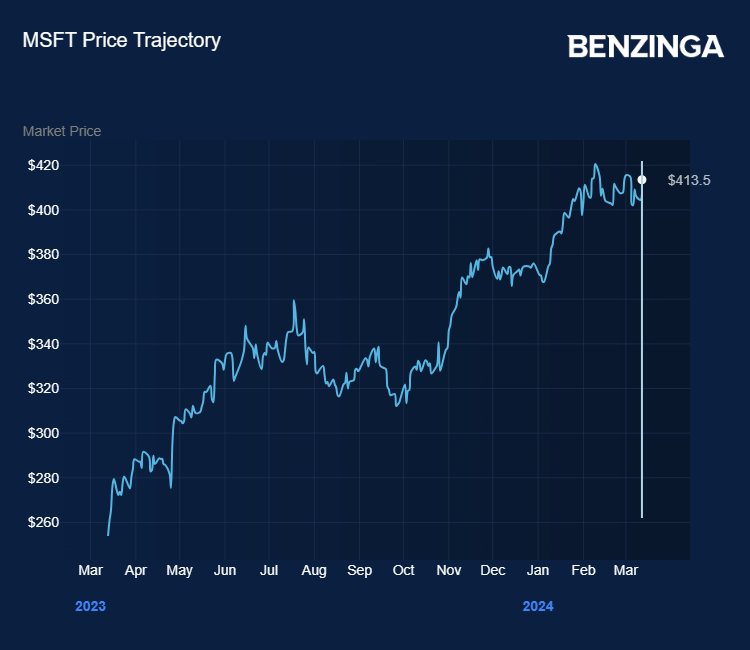Zinger Key Points
- Can China maintain the pace of development in the face of U.S. chip export controls?
- China has already launched more than 80 large language models, government dept says.
- Feel unsure about the market’s next move? Copy trade alerts from Matt Maley—a Wall Street veteran who consistently finds profits in volatile markets. Claim your 7-day free trial now.
Is there a Cold War-style gap opening up between the U.S. and China over their respective generative artificial intelligence (GenAI) capabilities?
Both countries have witnessed billions of dollars of investment, with funding from corporate, governmental and institutional investors, driving innovation at breakneck speed.
But has the pace become too quick for China? Its government and delegates at last week’s National People’s Congress say not.
Bloomberg reporter Sarah Zheng was there last week and spoke to the CEO of 360 Security Technology, who told her: “China's AI companies had developed quickly and basically managed to catch up to OpenAI's ChatGPT capabilities.”
That would suggest that China is roughly on par with the U.S. in terms of AI development.
Large Language Models: U.S. vs. China
Microsoft Corporation MSFT, which is the chief backer behind OpenAI, has licensed its partner’s developments in large language models and generative artificial intelligence (GenAI) to take, what many analysts feel, is the leading position in the U.S. AI industry.
Brad Reback, analyst at Stifel, said this of Microsoft last month: “We believe its increasing GenAI scale will become a meaningful competitive advantage as the company is able to leverage the virtuous circle generated by its unique Infrastructure & Application usage-based insights to inform its future investment and monetization strategies.”

Also Read: Microsoft’s GenAI Advantage Is ‘Distancing It From The Competition,’ Says Analyst
Arguments over whether China has a company or companies with the same level of expertise as OpenAI and Microsoft are not uncommon, with Baidu Inc.‘s BIDU launch of Ernie Bot last March, often cited in support of China’s efforts.
And, according to the Bureau of Economy and Information Technology, Chinese AI developers have already launched more than 80 large language models, including Tongyi Qianwent by Alibaba Group Holding BABA Cloud and Pangu 3.0 by Huawei Cloud.
Can China Stay The Pace In The AI Race?
But whether China can maintain the pace of development is a more pertinent question. Here, the U.S. clearly has the advantage.
In October last year, the Commerce Department announced it was extending controls — first announced in 2022 — over the export of technology such as advanced semiconductors and graphics processing units (GPUs) that “could fuel breakthroughs in AI and sophisticated computing.”
These components, made by companies such as NVIDIA Corporation NVDA, Advanced Micro Devices Inc. AMD and Intel Corporation INTC are the building blocks for training large language models such as ChatGPT.
Kendra Schaefer, head of tech policy research at Trivium China, told the BBC last year: “China’s ability to manufacture high-end equipment and components is an estimated 10 to 15 years behind global leaders.”
Gregory Allen, director of the Wadhwani Center for AI and Advanced Technologies, said in a report for the Center for Strategic and International Studies, said: “The United States does not want China to have advanced AI computing and supercomputing facilities, so it has blocked them from purchasing the best AI chips, which are all American.”
The disadvantages of such policy action are mainly felt by the U.S. companies that are losing business by being banned from selling their products to what should be a huge market.
The iShares U.S. Technology ETF IYW, which tracks the performance of the top tech and AI stocks, fell during 2022 as companies were restricted in their business dealings with China.
Photo: Shutterstock
Edge Rankings
Price Trend
© 2025 Benzinga.com. Benzinga does not provide investment advice. All rights reserved.
Trade confidently with insights and alerts from analyst ratings, free reports and breaking news that affects the stocks you care about.